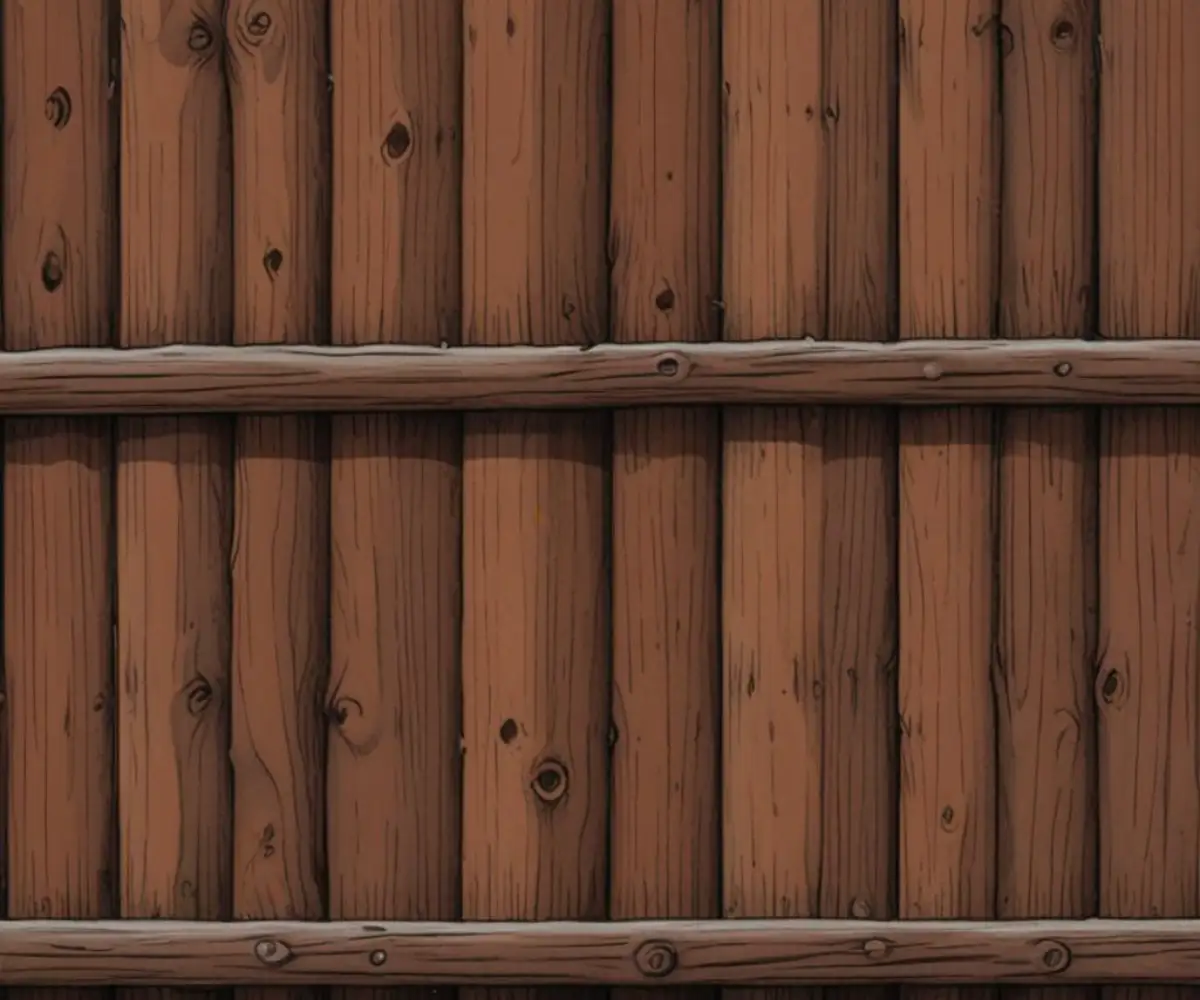How Long After Rain to Stain a Fence? The Critical Wait Time
The most overlooked step of staining a fence is perhaps simply waiting for the wood to dry out. Not only does rain wet the surface, but it also pushes water into the wood fibers, which prevents the stain from penetrating properly. Staining too soon after rain can leave you with a finish that is blotchy, peels prematurely, or fails to bond altogether. So get a head start on drying with the weather before grabbing brushes or a sprayer.
Waiting Time: 24 to 48 Hours (Occasionally Longer)
Most conditions require waiting at least 24 to 48 hours since last rain when staining. Many professionals and manufacturers suggest this period to allow the wood’s surface water to dry out and reduce the possibility of low adhesion or discoloration.
All that aside, actual drying time will vary by temperature, humidity, type of wood, and the extent to which the wood got wet. On dry, hot days, 24 hours would work well. On cold, humid days, you might end up requiring more like 48 hours or more, especially for oil-based stain since they take longer to dry.
You'll Learn About
The Costly Mistake: Why Staining a Damp Fence Is a Disaster
You’ve been waiting for the perfect weekend to tackle your fence staining project. The supplies are ready, but then an unexpected rain shower passes through. Now you’re left wondering, “how long after rain can you stain a fence?”
Rushing this critical step is one of the most common and disastrous mistakes a homeowner can make. Applying stain to wood that hasn’t dried sufficiently leads to a finish that peels, flakes, and looks blotchy, wasting all your hard work and money.
How Moisture Sabotages Your Stain Job
To understand why waiting is non-negotiable, you need to think about how wood and stain interact. Wood is a porous material, like a very dense sponge. When it rains, the wood fibers absorb water, filling up those microscopic pores.
Fence stain is designed to penetrate deep into these pores to protect the wood from the inside out and provide rich, even color. If those pores are already clogged with water, the stain has nowhere to go. It sits on the surface, unable to adhere properly, creating a weak film that will quickly fail.
This failure doesn’t just look bad; it can also trap moisture underneath the stain, promoting the growth of mold, mildew, and algae. The result is a fence that looks worse than when you started and is now at a higher risk of rot and decay.
The Golden Rule: Your Minimum Wait Time
The general rule of thumb is to wait a minimum of 24 to 48 hours after a rain shower before staining your fence. This allows the surface of the wood enough time to dry out under typical conditions. However, this is just a starting point.
Several critical factors can dramatically increase this waiting period. Treating the 24-48 hour rule as an absolute guarantee without considering other conditions is a recipe for failure. True success lies in understanding the variables at play.
Weather Conditions: The Most Important Factor
Your local weather forecast is the single most important element influencing your fence’s drying time. Look for a clear window with no rain expected for at least 24-48 hours AFTER you finish staining.
Sunlight is your best friend, as direct exposure significantly speeds up evaporation. A fence section that is in full sun all day will dry much faster than a section that remains in the shade. Be prepared for different parts of your fence to dry at different rates.
Humidity is the invisible enemy. Even on a sunny, rain-free day, high humidity in the air slows down the drying process because the air is already saturated with moisture. Staining on a day with over 80% humidity is not recommended, even if the wood feels dry to the touch.
Wood Type and Age Matters
The type and condition of your fence wood play a significant role. Older, weathered wood is often more porous and can absorb more water, potentially increasing the time it needs to dry out completely.
If you have a brand new fence made from pressure-treated wood, you have a different waiting game entirely. This wood is saturated with water and chemical preservatives at the mill and needs to dry for several weeks or even months before it’s ready for its first stain, regardless of recent rainfall.
The Pro’s Secret: How to Know for Sure Your Fence Is Dry
Instead of just guessing, you can use two simple and effective methods to determine if your fence is truly ready for stain. These tests remove all doubt and ensure you’re applying stain to a perfectly prepared surface.
The first is the “sprinkle test.” Go to a few different spots on your fence and sprinkle a small amount of water on the wood. If the water beads up on the surface, the wood is still sealed or contains too much moisture. If the water soaks into the wood within a few minutes, it’s a great sign that the wood is dry and porous enough to absorb stain.
The Foolproof Method: Using a Moisture Meter
For ultimate accuracy, nothing beats a wood moisture meter. This handheld device gives you a precise reading of the moisture content within the wood. It’s the same tool professionals rely on to guarantee a perfect finish.
To use it, you simply press the device’s pins into the wood. For staining, you want the moisture content to be 15% or less, with an ideal reading below 12%. Testing in multiple areas—sunny spots, shady corners, and near the bottom of the boards—will give you the complete picture.

Your Step-by-Step Guide to Staining After Rain
Once you’ve determined your fence is properly dry, it’s time to get to work. Following these steps will ensure a beautiful, long-lasting finish that protects your investment.
Step 1: Patiently Wait and Watch the Weather. First, give the fence at least 48 hours to dry. Then, check the forecast to ensure you have a clear, dry period for both the application and the initial curing of the stain.
Step 2: Prepare the Fence Surface. Rain doesn’t clean your fence. A pristine surface is crucial for proper stain adhesion. Use a quality wood fence cleaner to scrub away any dirt, grime, algae, or graying wood fibers. Sometimes, you may also be dealing with mineral deposits from your irrigation system; in these cases, you must remove sprinkler stains from your fence before applying any new finish.
Step 3: Perform the Moisture Test. Don’t skip this step! Confirm the wood is ready by performing the sprinkle test or, even better, by using a moisture meter to check that the content is below 15%.
Step 4: Apply the Stain Methodically. Apply the stain evenly with a brush, roller, or sprayer, following the manufacturer’s instructions. Work in manageable sections and maintain a wet edge to avoid lap marks. Always back-brush after spraying to ensure the stain penetrates evenly into the wood grain.
| Condition | Estimated Wait Time | Pro Tip |
|---|---|---|
| Light Rain, followed by full sun, low humidity | 24 – 48 hours | Test the sunny side first, but wait until the shady side passes the moisture test too. |
| Heavy, Soaking Rain, followed by cloudy, humid days | 72 hours – 1 week | Using a moisture meter is almost essential in this scenario. Do not rely on touch alone. |
| After a High-Pressure Power Wash | 48 – 72 hours minimum | Power washing forces water deep into the wood. This requires more drying time than rain. |
| Brand New Pressure-Treated Wood | 4 weeks – 6 months | Rain is not the primary factor here; the internal moisture from the treatment process must evaporate first. |
Critical Mistakes to Avoid for a Perfect Finish
Knowing what not to do is just as important as knowing the right steps. Avoid these common pitfalls to save yourself from a world of frustration.
Mistake #1: Ignoring High Humidity. Many people focus only on the absence of rain. A sunny but very humid day can be just as bad for drying as a cloudy day. The moisture in the air prevents the moisture in the wood from escaping.
Mistake #2: Staining in Direct, Hot Sunlight. While sun helps dry the fence, you should avoid applying the stain itself in the scorching midday sun. The heat can cause the stain to dry too quickly on the surface before it has a chance to penetrate, leading to an uneven, blotchy appearance and lap marks.
Mistake #3: Assuming Rain Washed the Fence. Rain can splash dirt and spores onto your fence. Always clean the wood properly before staining, even if it looks clean after a shower.
Frequently Asked Questions
Here are answers to some of the most common questions homeowners have about staining their fence in relation to rainy weather.
What if it rains unexpectedly right after I stain my fence?
This is a frustrating situation. If the stain was oil-based and had a few hours to penetrate, it may show some water spotting but could be okay. Water-based stains are more vulnerable and can be washed away or become streaky if they get rained on before they’ve had time to cure.
Does the stain type (oil vs. water-based) affect the wood’s drying time?
No, the waiting time for the wood to dry is the same regardless of the stain you plan to use. The wood must be dry for any type of stain to work properly. The difference is in their own curing process after application.
How do I fix a stain job that was ruined by moisture?
Unfortunately, there is no easy fix. The only proper solution is to completely remove the failed stain using a stripper and sander, clean the wood with a wood cleaner and brightener, let it dry completely, and then start the staining process all over again.
Long-Term Fence Protection and Maintenance
A great stain job is your first line of defense, but ongoing maintenance is key to a long-lasting fence. Periodically inspect your fence for any signs of wear, damage, or rot.
Pay close attention to areas where moisture can collect, like the base of the posts or where the fence meets other structures. Ensuring a proper seal on the gap between a fence post and the house can prevent water from getting trapped and causing premature decay. Proper maintenance sometimes also involves modifications, like if you need to shorten split rail fence rails for a new garden layout; always remember to stain the fresh-cut ends.
The Final Word: Patience Is Your Best Tool
When it comes to staining a fence, patience is just as important as the stain itself. The urge to get the job done quickly is understandable, but applying stain to a damp fence is a guaranteed way to waste your time and money.
By waiting for the wood to dry completely, checking the weather, and testing for moisture, you are setting yourself up for a beautiful, professional-quality finish. This patience will be rewarded with a fence that not only looks fantastic but is also well-protected from the elements for years to come.

